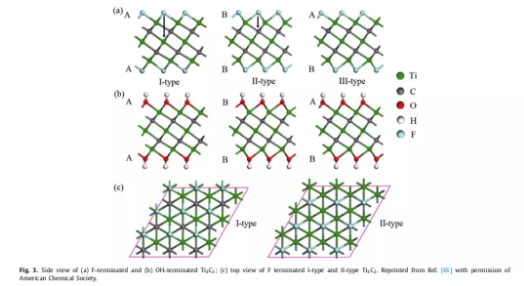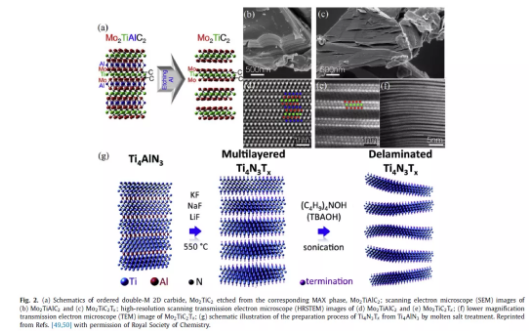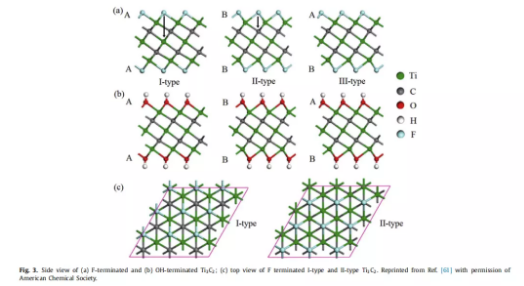
In recent years, a graphene-like structure MXene obtained by MAX phase processing has attracted extensive research attention. Many friends are full of curiosity about this material. Today, Xiaoman will show you the popular 2D material MXene.
1
What is MXene?
MXene is a graphene-like structure obtained by MAX phase processing. The specific molecular formula of the MAX phase is M n + 1 AX n (n = 1, 2 or 3), where M refers to the transition metals of the previous groups, A refers to the main group element, and X refers to C and/or N element. Because M-X has a strong bond energy and A has a more active chemical activity, A can be removed from the MAX phase by etching to obtain a graphene-like 2D structure-MXene.

▲Figure 1. The MAX phase and the corresponding etched MXene crystal structure
Since the first report of MXene (Ti3C2Tx, where T represents the surface terminal, including OH, O or F) in 2011, the laboratory has successively prepared various MXene materials. Khazaei et al. proposed that the ground state of many MXene materials (Cr2CT2 or Cr2NO2) is ferromagnetic, and the Seebeck parameter of semiconductor MXene is extremely high at low temperatures. Zhang et al. first proposed that the MXene (Ti2CO2) monolayer film has a high hole mobility and a low electron mobility of two orders of magnitude, and later confirmed the high carrier mobility in experiments. Due to the unique properties of MXene, it has been widely used in catalysts, ion sieving, photothermal conversion, field effect transistors, topological insulators and hydrogen evolution reactions.
2
How is MXene prepared?
As described above, since Naguib et al. first prepared Ti3C2Tx with hydrofluoric acid (HF) selective etching at room temperature (RT). More and more researchers are dedicated to finding new ways to prepare more MXene. Naguib et al. first proposed that after removing the A (Al) layer, the MX (Ti3C2) layer can be separated from the MAX (Ti3AlC2) phase, and then a new 2D Ti3C2 phase can be obtained by ultrasonic treatment. Then the influence of etching time, temperature, grain size and source of Ti3AlC2 on the preparation of 2D Ti3C2 by HF was systematically studied. In addition, the strength of the A bond also determines the etching conditions. Choosing appropriate etching conditions is the key to obtaining high yield and high purity.
Subsequently, in the same etchant HF experiment, more and more MXene was successfully obtained, including Ti2CTx, TiNbCTx, Ti3CNxTx, Ta4C3Tx, Nb2CTx, V2CTx, Nb4C3Tx, Mo2CTx, (Nb0.8Ti0.2)4C3Tx, (Nb0.8Zr0.2) 4C3Tx, Zr3C2Tx and Hf3C2Tx, of which Mo2C is the first MXene prepared by replacing the MAX phase with Mo2Ga2C. In addition, Zr3C2 is a kind of MXene prepared from Zr3Al3C5, which is a typical layered ternary and quaternary transition metal carbide, with the general formulas of MnAl3Cn+2 and Mn[Al(Si)]4Cn+3. M stands for Zr or Hf, and n is equal to 1–3. A new type of MXene, Hf3C2Yx, was obtained by selective etching of Hf3[Al(Si)]4C6. This result opens the door for the preparation of new MXene from more different precursors. In addition to the typical ternary MXene, Anasori et al. predicted the ordered double M 2D carbide MXene through density functional theory (DFT) calculations, and prepared Mo2TiC2Tx, Mo2Ti2C3Tx and Cr2TiCxTx using HF solution as an etchant.

▲Figure 2. (a) Mo2TiAlC2 etched into MoTiC2 atomic structure diagram, (bc) are SEM images of Mo2TiAlC2 and MoTiC2Tx, (de) are HRSTEM images of Mo2TiAlC2 and MoTiC2Tx, (f) are TEM images of MoTiC2Tx, ( g) The molten salt method prepares Ti4N3Tx through Ti4AlN3.
Halim et al. proposed NH4HF2 as a new etchant. The resulting MXene film interacts with NH3 and NH4+ ions, and its c parameter is 25% larger than the sample etched with HF. Ghidiu et al. reported the use of a mixture of HCl and LiF as an etchant instead of HF. The HF formed in situ selectively corrodes the A layer immediately, which is a simpler, safer and faster route. Because water and cations are intercalated between MXene layers, the MXene obtained has larger interlayer spacing and weaker interaction, and there are no nano-scale defects in the lamellae. Compared with the HF etching machine, the properties of LiF and HCl are mild. Much. In addition, fluorides such as NaF, KF, CsF, CaF2 can replace LiF, and H2SO4 can replace HCl. This method has been successfully applied to prepare a variety of MXenes, including Nb2CTx, Ti2CTx, Cr2TiC2Tx, Mo2TiC2Tx, Mo2Ti2C3Tx, (Nb0.8, Zr0.2)4C3Tx, and Mo2CTx.
3
The structure and electronic properties of MXene
In terms of structure, the precursor MAX phase can be considered as the alternate accumulation of the hexagonal MX layer and the A layer. The A layer is selectively removed, and the arrangement of the M and X atoms in the obtained MXene is similar to the corresponding precursor MAX. The M atoms are arranged in a close-packed array, and the X atoms occupy the center of the MX octahedron.
In experiments, MXene without any capping groups on the surface has not been prepared. Due to the use of fluoride-based etchant, the exposed M surface of the MXene layer is always terminated with -F, -O and -OH groups. For the sake of brevity, the surface capping group of MXene is usually expressed as Mn+1XnTx, where T represents the surface capping group, including OH, O and F. However, due to the presence of hydrogen atoms, OH end groups are not stable and can be replaced by alkali metals (such as Li, Na, and K), alkaline earth metals (such as Mg and Ca), or transition metals (such as Pb). In addition, at high temperatures, OH groups can be converted to O-type groups. Therefore, the surface of MXene may be quite complicated with one or some combination of OH, O and F and other end-capping groups. However, through chemical treatment, thermal annealing and mechanical exfoliation processes, MXene can generate specific end-capping groups. In addition, calculations show that O-end MXene can be decomposed into bare MXene and metal oxides by adsorbing multivalent metal atoms.
The surface functionalization of MXene is inevitable in the synthesis experiment, so it is especially important to understand the surface capping group. In previous work, Zhous research group studied the orientation of T including OH and F in Ti3C2T2. Three possible F and OH modes are studied, as shown in Figure 3. For configuration A, the end-capping group is located at the hollow position between three adjacent C atoms and directly connected to the middle titanium atom, while for configuration B, the terminal group is located at the top position of the C atom. Based on the results, it is shown that for Ti3C2(OH)2 and Ti3C2F2, the type I mode is more favorable, while the type II conformation is unstable. For most of the MXenes studied so far, Type I is predicted to be the most stable geometry. However, for configuration B, type II or type III are also reported to be the most stable of some MXene structures, because the end-capping group is closer to the carbon atom, which can donate electrons. In addition to theoretical research, many experiments have also focused on the surface capping group of MXene. Karlsson et al. observed that electron energy loss spectroscopy (EELS) of monolithic and two-piece MXene with atomic resolution obtained by atomic correction scanning transmission electron microscopy (STEM) revealed the inherent defects of the film, film coverage, and TiOx additional atomic complex . Using the same method, Wang et al. first proposed the surface structure and intercalation mechanism of Ti3C2X. In addition, through nuclear magnetic resonance (NMR) spectroscopy and total neutron scattering, the researchers conducted a detailed study of the surface functionalization of MXene.

▲Figure 3. (a) F-terminated and (b) side view of Ti3C2; (c) top view of F-terminated Type I and Type II Ti3C2.
The physical properties of MXene, including electronic properties, magnetism, dielectric constant and optical properties, were studied by calculation. Subsequently, a large number of experiments also focused on these properties to confirm the accuracy of theoretical predictions. The Matom largely determines the electronic properties of MXene. Interestingly, some MXene materials containing heavy elements, such as Mo and W, are predicted to be topological insulators. All exposed MXene materials are metallic, and after the surface is functionalized, some materials become semiconductors. For example, bare Ti3C2 has metallic properties, and the total magnetic moment per unit cell is 1.93μB. However, I-type F- and OH-Ti3C2 are semiconductors with a narrow band gap. In addition, the type and orientation of the capping group will also affect its electronic properties. The electronic properties of MXene are also related to the X atom. Since N has more electrons, carbonitride and nitride MXene have stronger metal properties than carbide MXene. The structure of Ti3CN(OH)2 is similar to Ti3C2(OH)2 and has metallic properties.
In addition to theoretical predictions, many experiments have focused on the electronic properties of MXene. Hu et al. evaluated the electronic conduction of a single Ti3C2Tx particle. Lipatov et al. measured the electronic properties of single-layer Ti3C2Tx sheets. The resistivity of a single Ti3C2Tx sheet is 2.31±0.57μΩm (4600±1100 S cm−1). Dillon et al. also proposed a high conductivity (6500 S cm−1). Halim et al. reported that Ti3C2Tx films have metallic conductivity below 100 K and below 100 K, their resistivity increases with decreasing temperature, and exhibits negative magnetoresistance at the lowest temperature, which indicates that Ti3C2Tx films have two-dimensional metallic properties. Through the temperature dependence test, Miranda et al. proposed that Ti3C2Tx can maintain its metallic properties even at the single-layer level. Calculation and experimental results show that MXene has excellent electrical properties and is a promising electrode material for energy storage.
Information source: Feynman Nano
This information is from the Internet for academic exchanges. If there is any infringement, please contact us and delete it immediately







